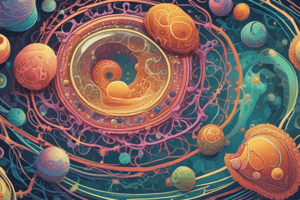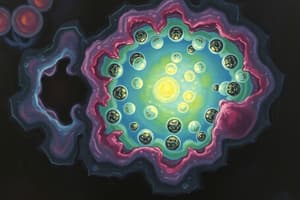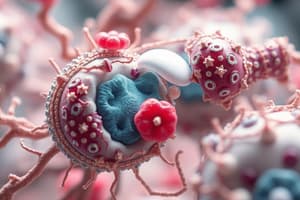Podcast
Questions and Answers
What is the structure of the nucleus?
What is the structure of the nucleus?
What is the function of the nucleolus?
What is the function of the nucleolus?
The nucleolus is where ribosomes are made.
What is the function of the nuclear envelope?
What is the function of the nuclear envelope?
What is the main function of the nucleus?
What is the main function of the nucleus?
Signup and view all the answers
What is the structure of the rough endoplasmic reticulum?
What is the structure of the rough endoplasmic reticulum?
Signup and view all the answers
What is the function of the rough endoplasmic reticulum?
What is the function of the rough endoplasmic reticulum?
Signup and view all the answers
What is the structure of the smooth endoplasmic reticulum?
What is the structure of the smooth endoplasmic reticulum?
Signup and view all the answers
What is the function of the smooth endoplasmic reticulum?
What is the function of the smooth endoplasmic reticulum?
Signup and view all the answers
What is the structure of the Golgi apparatus?
What is the structure of the Golgi apparatus?
Signup and view all the answers
What is the function of the Golgi apparatus?
What is the function of the Golgi apparatus?
Signup and view all the answers
What is the structure of mitochondria?
What is the structure of mitochondria?
Signup and view all the answers
What is the function of mitochondria?
What is the function of mitochondria?
Signup and view all the answers
What is the structure of chloroplasts?
What is the structure of chloroplasts?
Signup and view all the answers
What is the function of chloroplasts?
What is the function of chloroplasts?
Signup and view all the answers
What is the structure of a vacuole?
What is the structure of a vacuole?
Signup and view all the answers
What is the function of a vacuole?
What is the function of a vacuole?
Signup and view all the answers
What is the structure of lysosomes?
What is the structure of lysosomes?
Signup and view all the answers
What is the function of lysosomes?
What is the function of lysosomes?
Signup and view all the answers
What is the structure of cilia?
What is the structure of cilia?
Signup and view all the answers
What is the function of cilia?
What is the function of cilia?
Signup and view all the answers
Study Notes
Nucleus
- Surrounded by a nuclear envelope.
- Contains the nucleolus and chromatin, which coils into chromosomes during mitosis.
Nucleolus
- Site of ribosome production.
Nuclear Envelope
- Separates nucleus contents from the cytoplasm.
- Allows diffusion of substances; contains pores for mRNA and larger molecules.
Function of the Nucleus
- Acts as the control center of the cell.
- Stores the organism's genome and transmits genetic information.
- Provides instructions for protein synthesis.
Rough Endoplasmic Reticulum (RER)
- Consists of membranes with fluid-filled cisternae, continuous with the nuclear membrane.
- Coated with ribosomes, facilitating protein synthesis.
Function of the Rough Endoplasmic Reticulum
- Serves as a transport system within the cell.
- Offers large surface area for ribosomes, aiding amino acid assembly into proteins.
- Transports proteins to the Golgi apparatus.
Smooth Endoplasmic Reticulum (SER)
- Composed of membranes with fluid-filled cisternae, continuous with nuclear membrane.
- Lacks ribosomes on its surface.
Function of the Smooth Endoplasmic Reticulum
- Contains enzymes for lipid metabolism, including cholesterol and steroid hormone synthesis.
- Involved in lipid absorption and synthesis from the gut.
Golgi Apparatus
- Made up of a stack of membrane-bound flattened sacs.
Function of the Golgi Apparatus
- Modifies proteins by attaching sugars and lipids.
- Folds proteins into their tertiary structures.
- Packages proteins into vesicles for storage or secretion.
Mitochondria
- Enclosed by two membranes; the inner membrane forms folds called cristae.
- Contains a fluid-filled matrix, can vary in shape between spherical and rod-like.
Function of Mitochondria
- Primary site for ATP production through aerobic respiration.
- Self-replicating; abundant in energy-demanding cells like liver cells.
Chloroplasts
- Large organelles found only in plant cells.
- Surrounded by a double membrane; contains stacks of thylakoids with chlorophyll.
- Each stack is called a granum, surrounded by fluid-filled stroma.
Function of Chloroplasts
- Site of photosynthesis, where chlorophyll captures light energy to produce ATP.
- Splits water to provide H+ ions, which reduce carbon dioxide into carbohydrates.
- Abundant in leaf cells, particularly in the palisade mesophyll layer.
Vacuole
- Fluid-filled sac surrounded by a tonoplast membrane, found in plant cells.
Function of Vacuole
- Stores water and solutes, helping maintain turgidity and structure.
Lysosomes
- Small membrane-bound bags containing powerful digestive enzymes.
- Common in phagocytic white blood cells, aiding pathogen digestion.
Function of Lysosomes
- Keep digestive enzymes separate from other cellular components.
- Engulf and destroy old organelles or foreign matter.
Cilia
- Short, hair-like structures on the cell surface containing microtubules and centrioles.
Function of Cilia
- Beat in rhythmic patterns to facilitate movement or transport within the cell.
Studying That Suits You
Use AI to generate personalized quizzes and flashcards to suit your learning preferences.
Description
This quiz focuses on the functions and structures of key cellular organelles, such as the nucleus and nucleolus. Gain a deeper understanding of cellular components and their roles within the cell. Perfect for students studying cell biology or related subjects.




